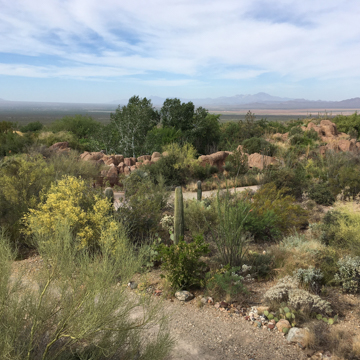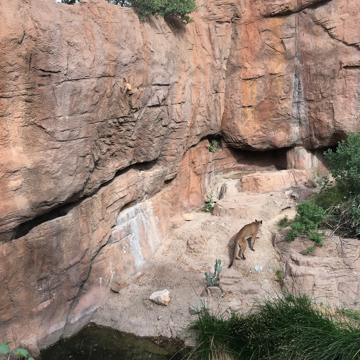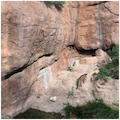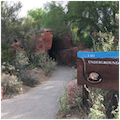The Arizona-Sonora Desert Museum is a 97-acre outdoor environment located 14 miles west of Tucson in the pristine, saguaro cactus–studded desert landscape that today borders Saguaro National Park West and Tucson Mountain Park. Founded in 1952 to interpret the natural history, plants, and animals of the Sonoran Desert, the museum is widely recognized as a pioneering institution for its innovative presentation and interpretation of native plants and animals featured together in ecological exhibits.
The Sonoran Desert, stretching south from southern Arizona to northern Sonora, Mexico, is one of the most ecologically diverse regions in the world. Interpreting this vast diversity was the inspiration of Arizona-Sonora Desert Museum founders William Carr and Arthur Pack. Carr came to Arizona after establishing the Bear Mountain Trailside Museums and Nature Trails in New York, where he developed his curatorial approach of working with native plants and animals to create a regionally focused collection. Pack, a conservationist and editor of Nature Magazine, was the museum’s initial benefactor.
Arriving in Tucson in 1944, Carr was inspired by the desert, but unimpressed by the way native plants and animals were presented in regional zoos. Determined to set aside a preserve, Carr worked with the Pima County Park Committee, which owned vast tracks of land encompassing the Tucson Mountains, which form the natural western boundary of the Tucson basin. He selected a desert site in the western (non-urbanized) foothills that contained a single structure: a Civilian Conservation Corps adobe building known as the Mountain House. Still in use at the museum’s entrance, the Mountain House became the first in the eventual museum complex of buildings, enclosures, trails, and interpretive experiences arrayed across the 97-acre site. Today, Pima County still owns the land, which it leases to the museum, which, in turn, is governed by an independent board.
In addition to preserving the pristine natural desert, as a way of interpreting its plant communities, the museum developed a unique design ethic of creating interpretive exhibitions that mimicked the natural environment of the animal communities enclosed within them. These environments included underground tunnels, caves, canyons, mountain habitats, grasslands, aquariums, aviaries, and numerous large animal enclosures for desert wildlife. Exhibit designer Mervin Larson perfected techniques of creating artificial rockwork of glass-fiber reinforced concrete whose realistic character blurs the lines between nature and enclosure—especially as perceived by museum visitors. Larson eventually became director of the museum and later founded the Larson Company, which went on to revolutionize zoo exhibit design, creating an entire industry devoted to the production of thematic simulated environments installed around the world.
Other interpretive experiences at the Museum include Water Street USA, focused on desert water usage and conservation; Life Underground, which exhibits animal dwelling strategies; the Sunset Magazine Desert Demonstration Garden, promoting residential desert landscaping; and Ancient Arizona, a fossil dig site for children. Visitor services and public programming have greatly expanded since the museum opened, including an expanded visitors' center and an art institute, a combined gallery and restaurant facility, and a theater, as well as other buildings and environments designed by renowned local architects and landscape architects.
References
Brusca, Richard C. Desert Gardens: A Photographic Tour of the Arizona-Sonora Desert Museum. Brentwood, TN: Cool Springs Press, 2010.
“History and Overview.” Arizona-Sonora Desert Museum. Accessed June 19, 2017. https://www.desertmuseum.org/.
Larson, Peggy Pickering, and William Ascarza. Arizona-Sonora Desert Museum. Charleston, SC: Arcadia, 2010.



















